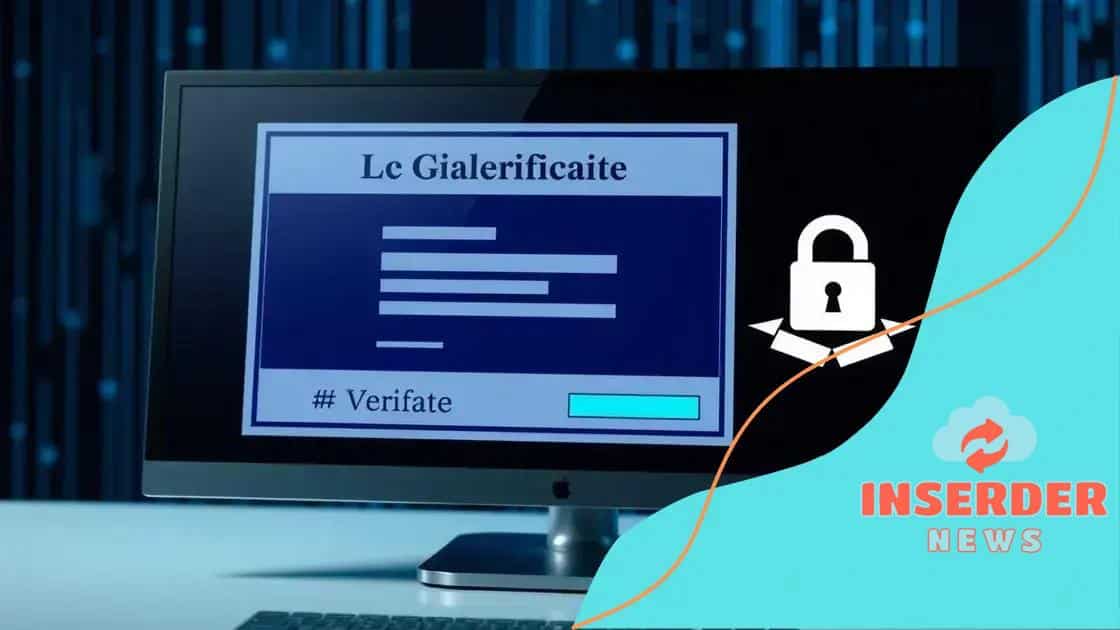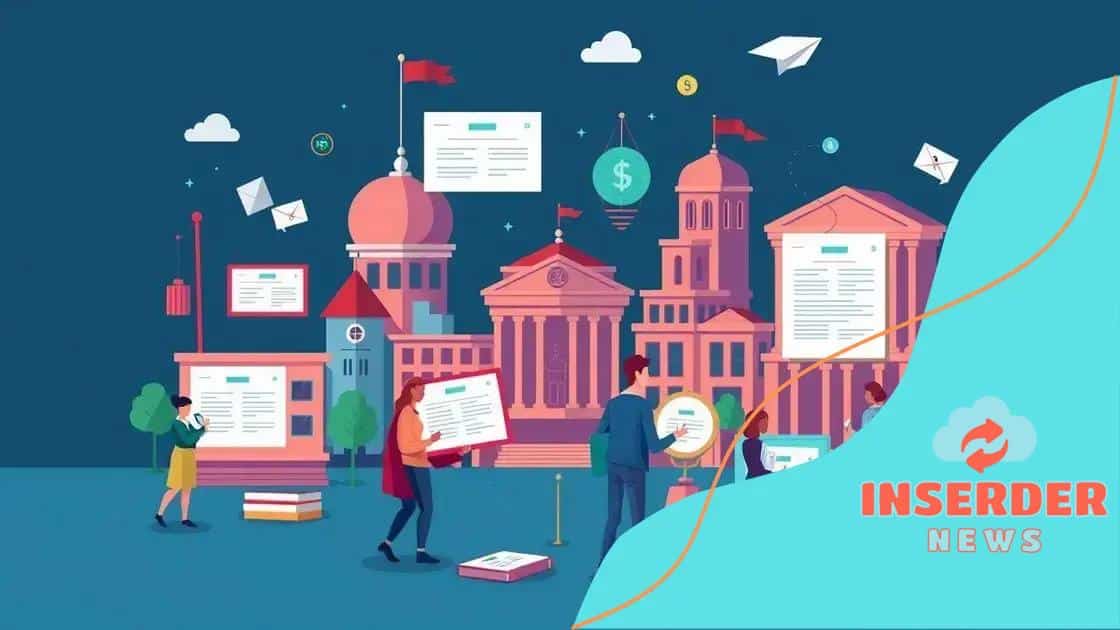How blockchain can secure academic credentials

Blockchain technology secures academic credentials by providing a tamper-proof, transparent system for managing, storing, and verifying educational records, enhancing trust and efficiency in the verification process.
How blockchain can secure academic credentials is a pressing question in today’s digital age. As degrees and certificates become easier to forge, educational institutions are turning to innovative solutions. What if blockchain could provide a reliable, tamper-proof method of verifying qualifications? Let’s dive into this fascinating topic.
Understanding blockchain technology
Understanding blockchain technology is vital for grasping how it can secure academic credentials. Essentially, blockchain is a decentralized and distributed ledger system that allows multiple parties to record and verify data securely. This means that once information is entered into the blockchain, it cannot be altered or deleted, making it highly reliable.
In education, the adoption of blockchain ensures that academic records are both transparent and secure. Institutions can store student achievements, diplomas, and other credentials on the blockchain, which can then be easily verified by employers and other educational entities.
Key Features of Blockchain
Some of the main features that contribute to the security of academic credentials include:
- Decentralization: No single entity controls the entire database, minimizing the risk of data tampering.
- Immutability: Once data is added, it cannot be changed without consensus, ensuring the integrity of records.
- Transparency: All transactions are visible to users with permission, providing the ability to track academic achievements.
Moreover, blockchain technology promotes greater efficiency. With traditional record-keeping methods, verification can take days or even weeks. In contrast, blockchain allows institutions to instantly confirm the validity of credentials, streamlining hiring processes.
Real-world Applications
Universities and colleges around the world are beginning to explore blockchain for various applications:
- Digital diplomas: Institutions are issuing blockchain-based diplomas that are easily shared with employers.
- Credential verification services: Startups are developing platforms specifically designed for verifying educational credentials using blockchain.
- Enhanced student records: Comprehensive student records can be created on the blockchain, detailing coursework and achievements.
As more educational institutions embrace this technology, understanding blockchain becomes essential for students and employers alike. By ensuring secure and verifiable academic credentials, blockchain can enhance trust in educational systems.
Benefits of blockchain for academic credentials
The benefits of blockchain for academic credentials are vast and significant. This innovative technology ensures that academic records are secure, verifiable, and easily accessible. By integrating blockchain, educational institutions can enhance trust and make the verification process simpler for employers and students.
One of the primary advantages is the reduced risk of fraud. With blockchain, each academic achievement is recorded in a way that cannot be tampered with. This transparency means that employers can trust the credentials presented by applicants without extensive background checks.
Enhanced Security
Moreover, the security of academic credentials is significantly improved. Blockchain utilizes cryptographic techniques to protect data, ensuring that only authorized personnel can access sensitive information. This enhanced security means that personal information and achievements are kept safe from unauthorized modifications.
- Immediate verification: Employers can verify credentials instantly without delays.
- Ownership control: Students maintain control over their academic records, deciding who can access them.
- Cost efficiency: Reduces the need for third-party verification services, saving time and resources.
Additionally, blockchain provides a permanent record of achievements. Unlike traditional methods, where paper diplomas can be lost or damaged, digital records on the blockchain are secure and permanent. This reliability increases the perceived value of the qualifications.
Accessibility and Interoperability
Another key benefit is the accessibility of records. Students can access their credentials at any time, allowing them to share them with potential employers or further educational institutions effortlessly. Furthermore, blockchain enables interoperability between different platforms, which means academic records can be easily transferred when students change institutions or pursue new opportunities.
By utilizing blockchain, educational institutions can stay ahead in a competitive landscape. Adopting this technology leads to a modernized system that benefits both students and employers. As we continue to explore the potential of blockchain for academic credentials, its advantages become increasingly clear, paving the way for a more secure and efficient future.
Real-world examples of blockchain in education

Real-world examples of blockchain in education are emerging as institutions look to enhance the security and verifiability of academic credentials. These practical applications showcase how blockchain technology is transforming traditional systems.
For instance, some universities are issuing diplomas using blockchain. These digital diplomas can be easily shared with employers or other educational institutions, making the verification process faster and more reliable. With blockchain, each diploma is tied to a unique digital signature that verifies its authenticity.
Case Study: MIT Media Lab
The Massachusetts Institute of Technology (MIT) is a pioneer in using blockchain for academic credentials. The MIT Media Lab has issued digital diplomas to graduates since 2017. These diplomas are stored on the blockchain, allowing students to manage and share their credentials securely.
- Instant verification: Employers can verify graduates’ diplomas quickly and without contact with the university.
- Reduced fraud: The digital nature of the diploma makes it much harder to forge.
- Student empowerment: Graduates have direct access to their credentials and can share them as needed.
Another great example is the University of Nicosia in Cyprus, which offers a Master’s degree in Digital Currency using blockchain. This program not only teaches students about cryptocurrency but also uses blockchain to issue certificates for course completion.
These certificates are tamper-proof and easily verifiable by potential employers. As the use of blockchain grows, more institutions are likely to adopt similar systems. This will lead to increased trust and security in the educational process.
Innovative Startups
Numerous startups are also making their mark in this space. For example, companies like Blockcerts and Learning Machine focus on providing institutions with the tools to issue and verify blockchain-based diplomas.
This technology allows educational bodies to digitize their credentials while maintaining a secure, immutable record. By observing these real-world implementations, it is clear that blockchain is more than just a trend; it is reshaping how institutions manage academic achievements.
Challenges of adopting blockchain in academia
While blockchain technology offers many benefits for academic credentials, there are also significant challenges in adopting it within academia. Understanding these challenges is crucial for institutions considering the transition to this innovative technology.
One major hurdle is the cost of implementation. Integrating blockchain requires investment in both technology and training. Institutions may need to upgrade their existing systems and invest in new infrastructure to support blockchain operations.
Technological Barriers
Another challenge relates to the technological complexity of blockchain. Many educational institutions may lack the technical expertise to implement and maintain blockchain systems. This gap can create dependency on third-party providers, which may introduce additional costs and security risks.
- Staff training: Institutions must ensure their staff is adequately trained to use the new technology.
- Integration issues: Existing systems might not easily integrate with blockchain solutions.
- Data privacy concerns: There is also worry about how student data will be stored and protected on a public blockchain.
Furthermore, gaining stakeholder buy-in is another significant challenge. Faculty, students, and administrative personnel must understand the benefits of blockchain and how it will impact their workflows. Resistance to change can slow down the adoption process.
Regulatory and Legal Concerns
Regulatory frameworks for blockchain are still evolving, leading to uncertainty about compliance. Institutional leaders must navigate varying regulations and laws related to data protection and privacy when adopting blockchain. This uncertainty can create hesitation among decision-makers.
In addition, the issue of interoperability arises; different institutions may use varying blockchain technologies, making it difficult to share and verify credentials across systems. As a result, efforts to create a unified framework for blockchain in education are essential but challenging. Addressing these obstacles will be key to successfully adopting blockchain technology in academia.
The future of academic credential verification with blockchain
The future of academic credential verification with blockchain is bright and filled with potential. As technology evolves, education systems are beginning to recognize the advantages of using blockchain to manage academic records.
By implementing blockchain, institutions can create a secure and transparent method for verifying credentials. This technology has the capacity to enhance trust between students and employers significantly. With instant access to verified records, hiring processes can become faster and more efficient.
Streamlined Processes
Imagine a world where students can easily share their academic achievements with prospective employers. With blockchain, students will have control over their records, deciding which credentials to share and with whom. This capability can lead to more streamlined hiring processes, as employers can quickly verify qualifications.
- Ease of access: Students and employers can access records anytime and anywhere.
- Redundant paperwork: Eliminates the need for physical copies of diplomas and transcripts.
- Real-time verification: Employers can verify credentials instantly, reducing wait times.
Furthermore, the adoption of blockchain technology can facilitate international recognition of academic credentials. Institutions worldwide can trust the verifiable records stored on the blockchain. This global acceptance can break down barriers for students looking to study or work internationally.
Innovative Solutions
Many startups and institutions are actively developing innovative solutions that harness blockchain for credential verification. For example, platforms are emerging that focus on allowing students to curate their portfolios on the blockchain, showcasing not only degrees but also certifications and other achievements.
In addition, partnerships between universities and blockchain technology firms are becoming more common. These collaborations aim to create standardized systems that will make the credential verification process even more reliable and efficient.
As the future unfolds, we will likely see expanded use of blockchain across various educational sectors. By investing in this technology, academic institutions can not only improve their operations but also provide a better experience for students and employers alike.
FAQ – Frequently Asked Questions about Blockchain for Academic Credentials
How does blockchain improve the security of academic records?
Blockchain uses cryptographic techniques to ensure that academic records cannot be altered, providing a tamper-proof system for managing credentials.
Can students easily share their blockchain credentials with employers?
Yes, students can quickly share their blockchain credentials with potential employers, making the verification process faster and more efficient.
What are some real-world examples of blockchain in education?
Many institutions, like MIT, are already issuing digital diplomas on the blockchain, allowing for instant verification and reduced fraud.
What challenges do universities face when adopting blockchain technology?
Challenges include the cost of implementation, the need for technical expertise, and regulatory compliance with data protection laws.






